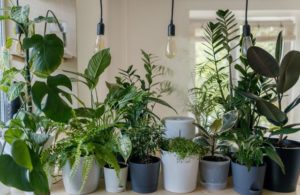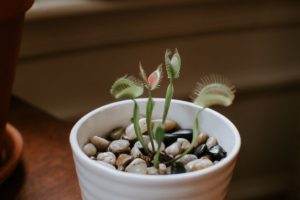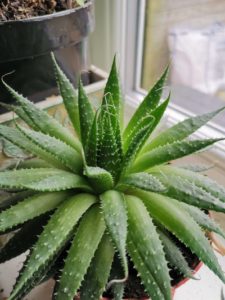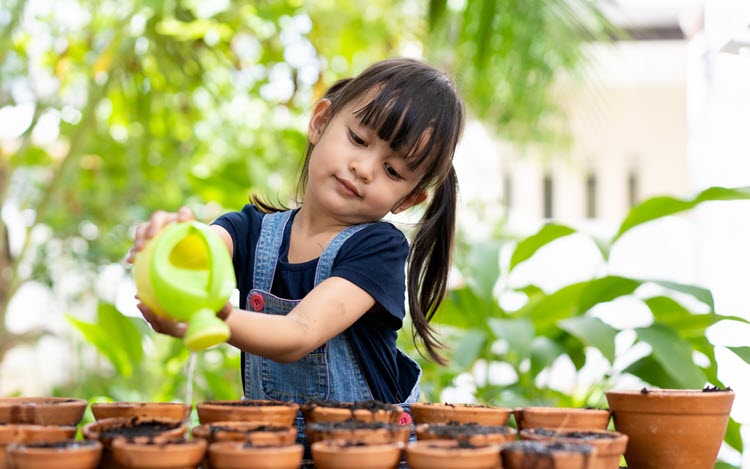When it comes to plants for kids, children find great magic in watching a plant grow. When they help that growth with their own hands, it can also give them a sense of accomplishment and confidence, along with a household responsibility.
A houseplant that’s easy to care for can give kids their first taste of gardening without requiring too much work from them (or you). A houseplant can also add a splash of color to your home.

Photo by vadim kaipov on Unsplash
1. Snake Plant
This pretty plant is a great plant for kids because doesn’t take too much charming to dance its way toward the ceiling. Its slender green leaves grow skyward whether it’s in the sun (though not direct) or shade, and you can forget to water it for a while without harming it.
Back in 1989, NASA did a study on plants to see which variety could help clean indoor air, and the snake plant appeared on their list. 1 Though the study was conducted years ago, its results have stood the test of time and so, too, has the snake plant’s ability to improve indoor air quality.
2. Philodendron
Philodendrons are easy to love and care for. They’re found high up in the trees of the rainforest, where it takes some heartiness to thrive. They prefer shady, dappled light that mimics their natural habitat. 2 There are different varieties, and some have fun-colored leaves. If the plant’s color starts to fade, it might need a little extra light. They need water every couple of weeks or however long it takes for the soil to become 80 percent dry.
3. Pitcher Plant
Carnivorous plants appeal to those kids who love to watch lions hunting in nature documentaries. These insect eaters can also be used to keep your bug population under control. There are several types of pitcher plants, and some varieties thrive in very specific climates. Others are hearty and adapt to different conditions fairly easily. These plants are low maintenance, requiring poor soil (they get nitrogen from their prey) with good drainage.3
4. Venus Fly Trap

Photo by Kelly Sikkema on Unsplash
Venus Fly Traps are another carnivorous plant that kids love thanks to the way their leaves trap their prey. These plants are native to tropical climates and thrive in poor soil. They get the nitrogen they need from the insects they eat. These plants need a few hours of full sun each day, a well-draining pot, and regular doses of insects.
5. Pothos
Pothos thrive in a wide range of environments, from low light and dry soil to bright, indirect light in a vase of water. They’re also not very picky about their soil, so you don’t need to worry too much about fertilizing either. Pothos are great low maintenance plants for kids because they’ll be fine if your little one forgets to water them on occasion.
6. Succulents
Succulents come in many shapes and sizes, and they’re low maintenance. Succulents are so easy to care for because they can go for several weeks without water. The trick is not to overwater them. How much water they need depends on the air temperature and climate. They’ll need less watering in a humid climate than in a dry one, and higher temperatures will dry them out faster than in cold ones. Kids can take responsibility for succulents by checking the plant’s soil with their fingers. Most succulents don’t need to be watered unless the soil feels dry. Kids can also check their health by gently squeezing the leaves. The leaves should fill plump and taut. If they don’t, it’s time for some water.
7. Chinese Evergreen
The Chinese Evergreen is a popular favorite because of the many colors and varieties available. Kids can pick silver, pink, green, or red. Some varieties grow tiny red fruit or white flowers, too. Most Chinese Evergreens are fairly hearty and tolerant of most conditions. The lighter the leaves are in color, the more sunlight (though not direct sunlight) this plant needs. Darker varieties can thrive in the lower light, though they prefer bright, indirect sunlight. This plant prefers moist soil. It’s time to water when the soil is damp two to three inches below the surface.
8. Spider Plant
The name alone makes the spider plant appealing to kids. Its thin, slightly drooping leaves are reminiscent of spider legs. This plant prefers bright, indirect light and needs watering when 50 percent of the soil is dry. They enjoy humidity, though they can survive in dry conditions. Keep an eye out for “pups” or “spiderettes,” the new plant offshoots that appear on mature plants. They can be fun to clip off and start another plant.
9. Lucky Bamboo
Lucky bamboo brings an exotic look to the home. It comes in fun twisting shapes that surround several stocks planted in a pot. They are native to the rainforest canopy, so bright, indirect light works best. They prefer soil that’s moist but not soaking. Lucky bamboo is sensitive to chemicals like chlorine. Use distilled, bottled, or tap water that’s been left out overnight so the chlorine can evaporate.
10. Christmas cactus
Christmas cactus is a succulent that produces brightly colored flowers. Unlike other succulents, Christmas cactus prefers slightly moist soil that’s closer to its natural conditions in the Brazilian rainforest. It can thrive in bathrooms thanks to its love of humidity. You can also buy a humidifier for plants for any room in the house. This colorful succulent needs to be watered once the first one or two inches of soil become dry.
11. Aloe Vera

Photo by Jude Smart on Unsplash
As a succulent, Aloe Vera is fairly easy to grow. They’re desert plants, so they thrive in drier conditions. Aloe Vera doesn’t need water until the soil is completely dry. Also, make sure that the water can completely drain, so it doesn’t linger around the roots. The fun part about having an aloe vera plant is that you can teach your kids about its medicinal purposes too.4 It’s a functional as well as an aesthetically pleasing plant.
Article Sources
Safe Smart Family uses only high-quality sources, including peer-reviewed studies, to support the facts within our articles. Read our editorial process to learn more about how we fact-check and keep our content accurate, reliable, and trustworthy.
- Wolverton BC, et al. A study of interior landscape plants for indoor air pollution abatement. NASA technical memorandum. 1989. Accessed April 28, 2022.
- Sadhana K. and Sudhadevi PK. Evaluation of different species/varieties of philodendron under indoor conditions. Advances in Life Sciences. 2016; 5 (9): 3754-3764. Accessed April 29, 2022.
- Mithofer A. Carnivorous pitcher plants: Insights in an old topic. Phytochemistry. 2011; 72 (13): 1678 – 1682. doi.org/10.1016/j.phytochem.2010.11.024
- Sanchez-Machado DI, et al. Aloe vera: Ancient knowledge with new frontiers. Trends in Food Science & Technology. 2017;61:94-102. doi.org/10.1016/j.tifs.2016.12.005


